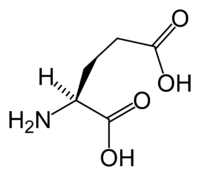
Photo from wikipedia
Parkinson’s disease (PD) is a common neurodegenerative disease implicated in multiple interacting neurotransmitter pathways. Glutamate is the central excitatory neurotransmitter in the brain and plays critical influence in the control… Click to show full abstract
Parkinson’s disease (PD) is a common neurodegenerative disease implicated in multiple interacting neurotransmitter pathways. Glutamate is the central excitatory neurotransmitter in the brain and plays critical influence in the control of neuronal activity. Impaired Glutamate homeostasis has been shown to be closely associated with PD. Glutamate is synthesized in the cytoplasm and stored in synaptic vesicles by vesicular glutamate transporters (VGLUTs). Following its exocytotic release, Glutamate activates Glutamate receptors (GluRs) and mediates excitatory neurotransmission. While Glutamate is quickly removed by excitatory amino acid transporters (EAATs) to maintain its relatively low extracellular concentration and prevent excitotoxicity. The involvement of GluRs and EAATs in the pathophysiology of PD has been widely studied, but little is known about the role of VGLUTs in the PD. In this review, we highlight the role of VGLUTs in neurotransmitter and synaptic communication, as well as the massive alterations in Glutamate transmission and VGLUTs levels in PD. Among them, adaptive changes in the expression level and function of VGLUTs may exert a crucial role in excitatory damage in PD, and VGLUTs are considered as novel potential therapeutic targets for PD.
Journal Title: Frontiers in Molecular Neuroscience
Year Published: 2023
Link to full text (if available)
Share on Social Media: Sign Up to like & get
recommendations!